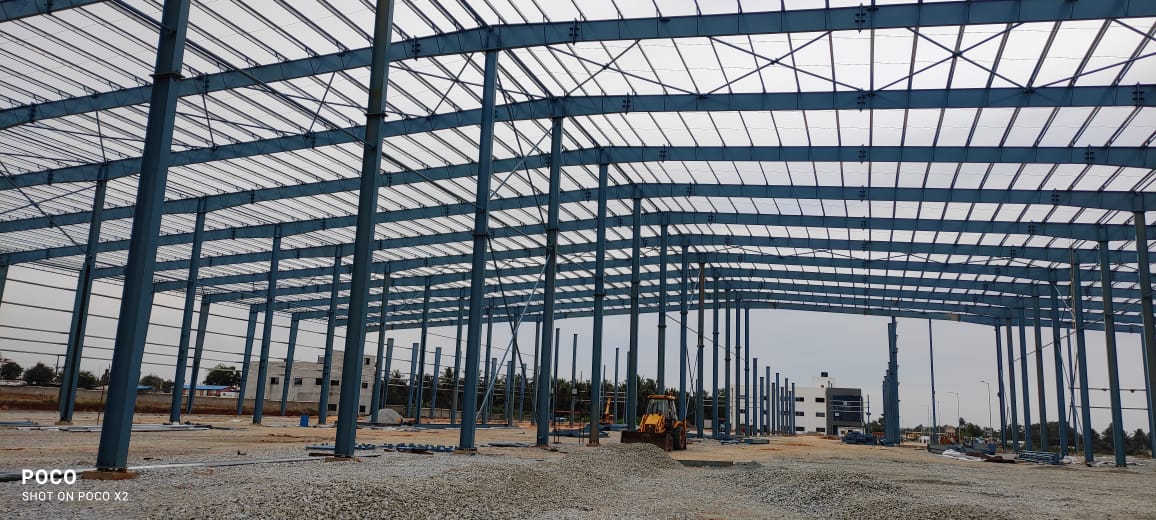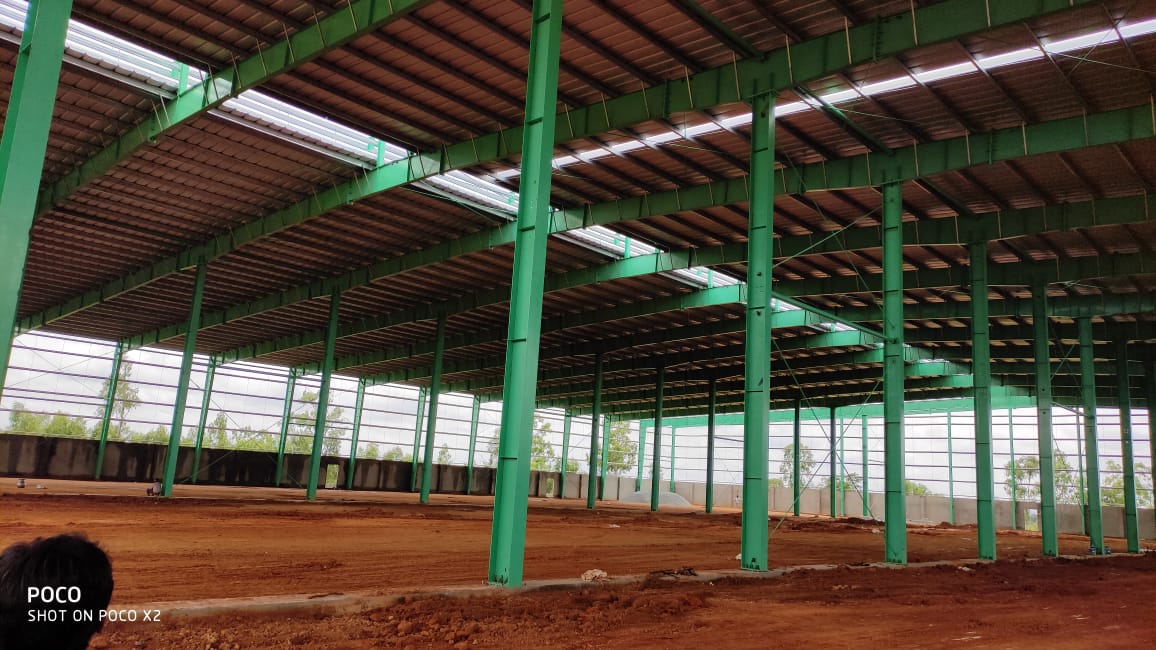Pre-Engineered Building an Insight :
The pre-engineered metal building system is a building enclosure system that always includes a structural system and often includes roof and wall cladding. The structural system consists of rigid frames that are fabricated from plate steel and “cold formed” through a manufacturing process. These rigid frames consist of roof beams and columns that are field bolted together.
The pre-engineered metal building system is advantageous because it very economically allows for the creation of large column-free enclosures. The alternative structural framing choices, such as mill steel and light gauge metal, use more steel and are therefore considerably more expensive to build. The best applications for the pre-engineered metal building system include industrial applications such as complex industrial facilities, warehouses and distribution centres. The system is also used in retail stores, shopping centres, office complexes, airplane hangars, sports and entertainment arenas as well as schools,medical facilities and government buildings.
THE COMPONENTS OF PEB SYSTEM
These PEB buildings are composed with the combination of various sections they are built up sections, hot rolled sections and the elements of cold formed sections. The basic steel frame work is provided by these elements. The PEB components may be broadly classified into following parts they are as follows:
Primary Frame – Pre-engineered steel building is portal frame construction comprises of primary and secondary framing and bracing system. A combination of these three elements and weather covering sheeting results in stable steel buildings instead of individual frame.
Secondary structural frames – Secondary framing system is mainly purlin and girt of Z or C shapes of various sizes. In Pre-engineered buildings normally cold form Z sections are used for secondary framing to achieve high strength and lower weight. Purlins/girt are members which transfers forces and moments from one frame to another frame for overall stability of the building structure and it all acts as framing system for weather covering sheeting purpose.
Roof and Wall Panels – Tin shades & Curtain Wall made of Glass & Roll-formed steel sheets usually comes in the category. From transfer of wind force and other acting loads form building frame to the foundation at certain interval. X-bracing system is used to change the direction of forces for reducing the impact of forces. Normally rod, pipes or angles are used for x-bracing purpose.
Sandwich Panels – Sandwich panel is made of three layers in which a non-Aluminium Core is inserted between two aluminium sheets.
Weather covering for roof and walls – In order to provide weather covering for roof and walls from external condition, steel structure need to be covered fully/partially as per functional requirements. For all purposes this covering provides access for all architectural and function requirements as well. Normally, metal profiled steel sheets are used for covering purpose. Now a day’s different color/color combinations are used to make building more aesthetic & elegant. There are various other elements of sheeting such as flashings, trims, ridge cover, peak panel, rack trim, drip trim etc. which is made of the same material as of sheeting and equally important for weather tight functioning of the building. In addition, proper rain water gutter for collection of rainwater and down take pipe for discharge of water from gutter to the ground is also a key element to the building for overall performance of the building. All sheetings are joined together with the help of self drilling/self tapping screw and necessary sealing material such as butyl tape, sealant, foam filler etc. are used to make buildings more efficient.
Mezzanine system – Now a day’s construction of mezzanine system is very common being used in steel building for various purposes. In most of the factory or warehouse building shop floor office, production offices, stores, maintenance office, wash rooms, canteen etc. are made above the shop floor area wherever surplus head rooms are available. This also helps in saving the floor area as well creates ease of serving being closely. This also reduces the cost of construction A typical mezzanine system is basically a joist beam construction taking support from the building columns as per availability and top of beams and joist deck slab is poured over GI decking of profiles metal sheet. A light reinforcement over decking and light concrete is used to make a permanent floor. Typical mezzanine details for various elements are shown below.
Anchoring – In order to install the steel building on RCC pedestal/foundation, it is necessary to have an anchoring system suitably designed to take up various loads and forces of the building and to transfer the same to the ground through anchor bolts arrangement. Size of anchor bolts and its quantities are designed as per reactions calculated as per building design.
Building accessories – There are various other building elements which may not be important structurally but very important functionally and it adds performance of the building. Skylight, wall light, Doors, windows, louvers, ventilators, turbo-vent, insulations, roof curb etc. are equally important to the smooth functioning of the building.
Crane system – All pre-engineered steel buildings can be designed for crane operation provision as per operational need. There is various type of crane being used in industry for various purposes- EOT overhead crane with pendant or cabin operated, Overhung/under-slung crane system, Monorail crane or hoist system, Wall mounted crane and Jib crane.
Paints and finishes – Pre-painted steel is produced on modern, high-speed coil painting lines where surface preparation prior to painting, paint application & paint curing is done on a highly automated line under optimum condition.
For the construction of these structures use of hot rolled tapered sections for primary framing and cold formed sections may be used as per the internal requirements for the stress for secondary framing, thus the control of wastage of steel and the weight of the structure and hence lighter foundations. These kinds of structures are basically rigid jointed structure frames from hot rolled or cold formed sections, the roofs and side wall cladding is supported by main and secondary frames by purlins and sheeting rails. For the selection of PEB roof slope is selected from 5 to 12 degree, because of least volume of air occupied during heating and cooling of the structure. To achieve the reduction in time of design, fabrication and installation the pre-engineered building system concentrates on the use of pre-designed connections and predetermined material stocks for structure to design and fabricate.
Pre-Engineered Buildings:


PEB VS CONVENTIONAL BUILDINGS
| PEB | Conventional Buildings | |
| Structure weight |
30% lighter through optimum use of steel, Primary framing members are varying depth sections with larger depths in areas of high stress Secondary members are light gauge (light weight) roll formed 'Z' or 'C' shaped members |
Primary members selected from standard sections, which can be heavier than required, Members have constant cross-sections regardless of local stresses along member length Secondary members are selected from standard hot rolled 'I' or 'C' sections, which are heavier |
| Design |
Quick and efficient, since basic designs can be reused and built upon. Specialized computer analysis and design programs optimize material required. Computerized drafting using standard details minimizes custom details. PEB engineers design & detail almost every day throughout the year resulting in faster & more efficient designs. |
Each structure designed from scratch. Substantial engineering & detailing required on every project. Generalized computer analysis is require extensive input/output & design alterations. Each project is a separate case, engineers need more time to develop the design & details of the unique structure. |
| Delivery | 6 to 8 weeks on average | 20 to 26 weeks on average |
| Foundations | Simple design, easy to construct | Extensive, heavy foundations required |
| Erection cost and Time |
Both costs & erection time are accurately known. Erected by specialized PEB builders with extensive experience in erection of similar buildings. A stock of standard components enables on-time job completion should any shortage or on-site damage occur to materials. Erection process is easy, fast, step-by-step and with minimum equipment requirement |
In most cases, erection costs and time are not estimated accurately. Erection is slow and extensive since more field labour and heavy equipment are often required |
| Seismic Resistance | Low-weight, flexible frames offer higher resistance to seismic forces | Heavy, rigid structures do not perform well in high-risk seismic zones |
| Overall Price | Price per square meter may be up to 30% lower than conventional buildings | They have a higher price per square meter than PEB |
| Architectural Design | Outstanding architectural design can be achieved at low cost using standard architectural features and interface details. | Special architectural design and features must be developed for each project, which often require research and thus resulting in much higher costs. |
| Sourcing & Coordination | Building is supplied complete with cladding and all accessories including erection (if desired) from one single source. | Many sources of supply, project management time is required to coordinate suppliers and sub-contractors. |
| Responsibility | Single source of supply results in total responsibility by one supplier, including design liability. PEB manufacturers can be relied upon to service their buildings long after they are supplied to protect their reputation. | Multiple responsibilities can result in questions of who is responsible when components do not fit properly, insufficient material is supplied, or materials fail to perform, particularly at the supplier/contractor interface. The consultant carries total design liability. |
| Performance |
All components are designed specifically to act together as a system, for maximum efficiency, precise fit, and peak performance in the field. Experience with similar buildings, in actual field conditions, has resulted in design improvements overtime, which allow dependable prediction of performance. |
Components are custom designed for a specific application on a specific job. Design and detailing errors possible when assembling the diverse components into unique buildings. Each building design is unique, so prediction of how components will perform together is uncertain. Materials which have performed well in some climates may not do so in other environments. |

